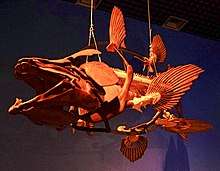Mawsonia (fish)
Mawsonia is an extinct genus of prehistoric coelacanth fish, and the largest of this group, ranging from an estimated 3.5 metres (11.5 feet) up to 6.3 metres (20.7 feet) long.[2][3] It lived during the Cretaceous period (Albian and Cenomanian stages, about 99 to 112 million years ago). Fossils have been found in the Tegana and Aoufous Formations of Morocco, the Continental intercalaire of Algeria and Tunisia and the Ain el Guettar Formation of Tunisia, Africa, the Babouri Figuil Basin of Cameroon and the Bahia Group and Alcântara and Missão Velha Formations of Brazil, South America. Mawsonia was first described by British palaeontologist Arthur Smith Woodward in 1907.[4] The type species is Mawsonia gigas, named and described in 1907. Seven other species have been described since.
| Mawsonia | |
|---|---|
 | |
| Reconstructed skeleton of M. lavocati at the National Museum of Nature and Science, Tokyo | |
| Scientific classification | |
| Kingdom: | Animalia |
| Phylum: | Chordata |
| Order: | Coelacanthiformes |
| Family: | †Mawsoniidae |
| Genus: | †Mawsonia Woodward, 1907 |
| Species | |
| |

References
- Sereno, P. C.; Dutheil, D. B.; Iarochene, M.; Larsson HCE; Lyon, G. H.; Magwene, P. M.; Sidor, C. A.; Varricchio, D. J.; Wilson, J. A. (1996). "Predatory Dinosaurs from the Sahara and Late Cretaceous Faunal Differentiation". Science. 272 (5264): 986–91. Bibcode:1996Sci...272..986S. doi:10.1126/science.272.5264.986. PMID 8662584.
- A giant marine coelacanth from the Jurassic of Normandy, France
- 2008 - De Carvalho & Maisey - New occurrence of Mawsonia (Sarcopterygii: Actinistia) from the Early Cretaceous of the Sanfranciscana Basin, Minas Gerais, southeastern Brazil
- Mawsonia at Fossilworks.org
Further reading
- Fishes of the World by Joseph S. Nelson
- History of the Coelacanth Fishes by Peter Forey
- Discovering Fossil Fishes by John Maisey and John G. Maisey
- The Rise of Fishes: 500 Million Years of Evolution by John A. Long
- Evolution of Fossil Ecosystems by Paul Selden and John Nudds